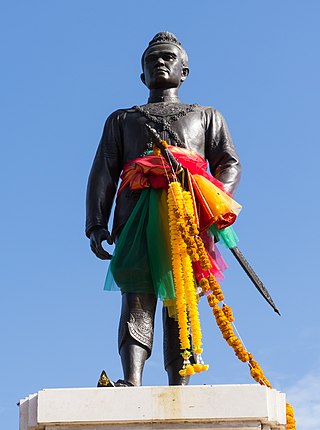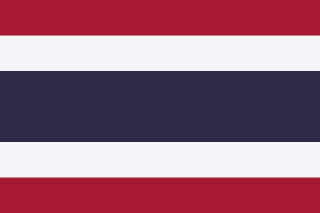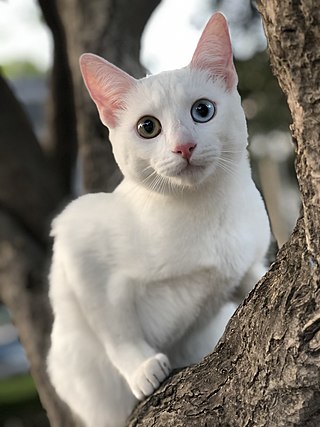Kingdom of Siam may refer to:
- Sukhothai Kingdom (1238–1351)
- Ayutthaya Kingdom (1351–1767)
- Thonburi Kingdom (1768–1782)
- Rattanakosin Kingdom (1782–1932)
- Thailand before 24 June 1939 and again from 8 September 1945 to 20 July 1949
Kingdom of Siam may refer to:
Siam is the former name of Thailand, and is used to refer to the historical region of Central Thailand, usually including Southern Thailand.
Year 1351 (MCCCLI) was a common year starting on Saturday of the Julian calendar.

The Ayutthaya Kingdom or the Empire of Ayutthaya was a Siamese kingdom that existed in Southeast Asia from 1351 to 1767, centered around the city of Ayutthaya, in Siam, or present-day Thailand. European travellers in the early 16th century called Ayutthaya one of the three great powers of Asia. The Ayutthaya Kingdom is considered to be the precursor of modern Thailand, and its developments are an important part of the history of Thailand.

The Thai solar calendar was adopted by King Chulalongkorn in 1888 CE as the Siamese version of the Gregorian calendar, replacing the Thai lunar calendar as the legal calendar in Thailand. Years are now counted in the Buddhist Era (B.E.): พุทธศักราช, พ.ศ.RTGS: Phutthasakkarat which is 543 years ahead of the Gregorian calendar.

Phra Bat Somdet Phra Phutthayotfa Chulalok Maharat, personal name Thongduang (ทองด้วง), also known as Rama I, was the founder of the Rattanakosin Kingdom and the first monarch of the reigning Chakri dynasty of Siam. His full title in Thai is Phra Bat Somdet Phra Paramoruracha Mahachakkriborommanat Phra Phutthayotfa Chulalok. He ascended the throne in 1782, following the deposition of King Taksin of Thonburi. He was also celebrated as the founder of Rattanakosin as the new capital of the reunited kingdom.

King U-thong or King Ramathibodi I was the first king of the kingdom Ayutthaya, reigning from 1351 to 1369.

Thonburi is an area of modern Bangkok. During the era of the Kingdom of Ayutthaya, its location on the right (west) bank at the mouth of the Chao Phraya River had made it an important garrison town, which is reflected in its name: thon (ธน) a loanword from Pali dhána 'wealth', and buri (บุรี), from púra, 'fortress'. The full formal name was Thon Buri Si Mahasamut. For the informal name, see the history of Bangkok under Ayutthaya.

Northern Thailand, or more specifically Lanna, is geographically characterised by several mountain ranges, which continue from the Shan Hills in bordering Myanmar to Laos, and the river valleys which cut through them. Though like most of Thailand, it has a tropical savanna climate, its relatively high elevation and latitude contribute to more pronounced seasonal temperature variation, with cooler winters than the other regions.

Lak mueang are city pillars found in most cities of Thailand. Usually housed in a shrine which is also believed to house Chao Pho Lak Mueang, the city spirit deity. It was constructed because the continuation of ancient traditions and Brahman's customs believed that it has something to do with the Held, the single city pillar ceremony which is made of an Acacia wood Chaiyaphreuk before the construction of the city for a major goal to build a city and to be the centre of soul for the citizens.

The Thonburi Kingdom was a major Siamese kingdom which existed in Southeast Asia from 1767 to 1782, centered around the city of Thonburi, in Siam or present-day Thailand. The kingdom was founded by Taksin the Great, who reunited Siam following the collapse of the Ayutthaya Kingdom, which saw the country separate into five warring regional states. The Thonburi Kingdom oversaw the rapid reunification and reestablishment of Siam as a preeminient military power within mainland Southeast Asia, overseeing the country's expansion to its greatest territorial extent up to that point in its history, incorporating Lan Na, the Laotian kingdoms, and Cambodia under the Siamese sphere of influence.
Rattanakosin is the period of Thai history since 1782, represented by the Rattanakosin Kingdom.

The following outline is an overview of and topical guide to Thailand.

The monarchy of Thailand refers to the constitutional monarchy of the Kingdom of Thailand. The king of Thailand is the head of state and head of the ruling Royal House of Chakri.

The Khao Manee cat, or Khao Plort, also known as the Diamond Eye cat, is a rare, natural breed of domestic cat originating in Thailand, which has an ancient ancestry tracing back hundreds of years. They are mentioned in the Tamra Maew. Khao Manee cats are short-haired solid-white cats.
Singu Min was the fourth king of the Konbaung dynasty of Myanmar.
Honorifics are a class of words or grammatical morphemes that encode a wide variety of social relationships between interlocutors or between interlocutors and referents. Honorific phenomena in Thai include honorific registers, honorific pronominals, and honorific particles.
Borommaracha or Borom Racha, or the extended version Borommarachathirat or Borom Rachathirat, was a Thai royal title, and may refer to:

Phra Nakhon Si Ayutthaya, or locally and simply Ayutthaya is the capital of Phra Nakhon Si Ayutthaya province of Thailand. Ayutthaya was the capital of the Ayutthaya kingdom. Located on an island at the confluence of the Chao Phraya and Pa Sak rivers, Ayutthaya is the birthplace of the founder of Bangkok, King Rama I. The ruins of the old city are preserved in the Ayutthaya Historical Park.
The known history of the monarchy of Thailand begins with the founding of the Sukhothai Kingdom, inaugurated by Si Inthrathit in 1238. This was succeeded by the Ayutthaya Kingdom and the short-lived Thonburi Kingdom. The present reigning dynasty, the Chakri Dynasty, took the throne in 1782, founding the Rattanakosin Kingdom. The present-day constitutional monarchy was established in 1932. The Chakri kings are often known as Rama: the reigning monarch is King Rama X (Vajiralongkorn).
Wurfbainia vera is a herbaceous plant in the Zingiberaceae family. Formerly called Amomum verum, it was the first plant species to be named by a woman, the Scots artist Elizabeth Blackwell in 1757. The Kingdom of Siam obtained the fruit (seeds) of the plant from Cambodia in the 18th century to export as a spice to China and Europe. As well as Cambodia the species is found in Sumatra, Thailand and Vietnam. The young leaf, the fruit and the seeds are edible, the seeds are known as Siam cardamom in English.